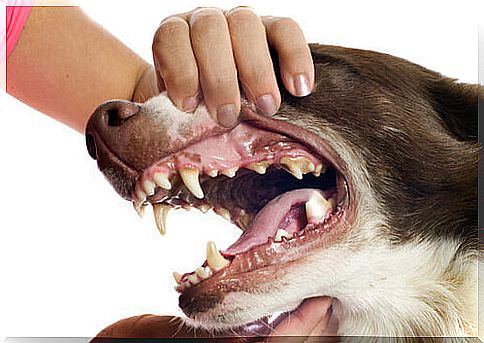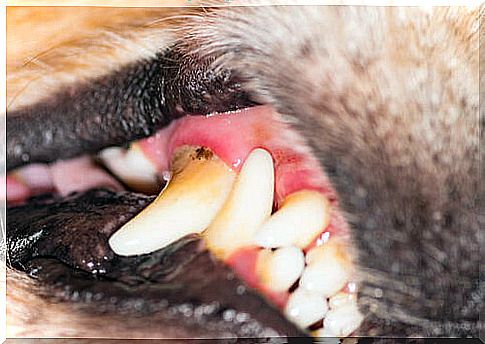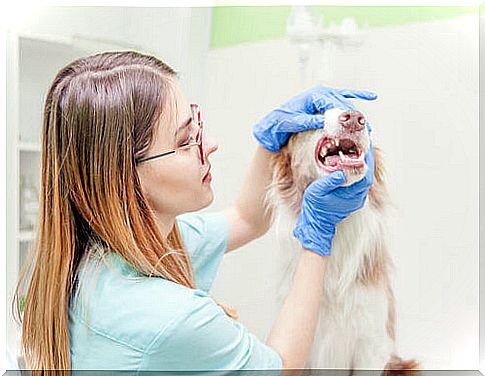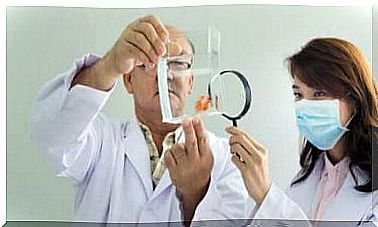6 Consequences – Even Serious Ones – Of Tartar In Dogs

Dog dental health is something owners tend to pay little attention to. Many believe that their four-legged friends, due to their “wild” nature, do not need dental care and teeth cleaning. Nothing is further from the truth because, believe it or not, the consequences of tartar in dogs can be serious.
As excessive as it may seem, vets recommend brushing your dog’s teeth every day. It has been scientifically proven that this greatly reduces the chances of bacterial diseases and inflammation of the gums (gingivitis), among many other conditions.
What is tartar?
As indicated by specialized dental health sites, tartar is dental plaque that has hardened due to the precipitation of minerals in saliva and gum fluid. Oral tartar consists of organic and inorganic matter, but the latter is predominant – up to 60% of the total.
This material feeds the larger surface bacteria-formed dental plaque, which can lead to a number of minor but also serious diseases in both dogs and humans. Therefore, tartar is not just an aesthetic problem: it can compromise the health of the teeth.

What are the consequences of tartar in dogs?
The formation of tartar not only compromises the dog’s oral hygiene, but can lead to certain systemic diseases in the most severe cases. Next, we show you the 6 consequences of tartar in dogs.
1. Halitosis
Bad breath in dogs is very common, especially in older dogs. The fact that your dog’s mouth smells bad is completely normal, because it is in close contact with feces, decaying matter and other organic elements that, for humans, are unpleasant but which are indispensable for the dog. .
When your dog’s breath resembles the smell of a garbage can, something is definitely wrong, especially if it’s small. Many times these strong odors come from bacterial colonies that have lodged in the oral mucosa.
2. Gingivitis
Gingivitis is inflammation of the oral, lingual or oropharyngeal mucosa of the dog. This causes the animal to develop mouth ulcers, excessive salivation and even difficulty eating.
When a dog has tartar, pathogenic bacteria build up on the gums, releasing toxins and damaging surrounding tissues. The animal’s immune system reacts by sending white blood cells to the site of infection, a process by which the characteristic inflammation of the gums is generated.
3. Periodontitis
If gingivitis is not treated promptly, periodontitis appears. In this case, the inflammation of the gums is much more serious, as it is accompanied by a degeneration of the bones and supporting structures around the dog’s teeth.
This process can be controlled but not completely repaired, as the bone damage has already been done and there is no going back.
It is the most common cause of dental disease in dogs: veterinarians estimate that 80% of domestic dogs suffer from periodontitis or a similar condition from 2 years of age. Bad breath is the first recognizable clinical symptom of periodontitis, but it can have worse consequences if not treated in time.
4. Tooth loss, a serious consequence of tartar in dogs
This process is linked to periodontitis, as pathogenic oral bacteria cause the teeth and surrounding structures to degenerate. Dental fractures can be complicated, depending on whether the nerves and blood capillaries are exposed after the injury.
The most common symptoms after tooth loss or breakage are pain, discomfort and bleeding near the compromised structure. If this injury is not treated, it can lead to a serious infection.
5. Endocarditis: a consequence of tartar in dogs
Endocarditis is an infection of the endocardium, the tissue that lines the insides of the valves and chambers of the heart. Oddly enough, bacteria that grow in the dog’s mouth can infiltrate the bloodstream (bacteremia) and, from there, migrate and settle in the heart tissue.

This results in symptoms such as lethargy, anorexia, weight loss and weakness in the animal. Shortness of breath, increased blood pressure, and fever may also occur. Endocarditis, if not treated with antibiotics, can be fatal.
6. Renal and hepatic insufficiency
Bacteria that enter the blood following periodontitis can also affect the liver and kidneys. This results in kidney and liver failure leading to extensive symptoms, depending on the type and severity of the infection.
As we have seen, the consequences of tartar in dogs go far beyond halitosis. Bacterial colonies that settle due to poor oral hygiene can cause tooth decay, gingivitis, and even serious systemic disease.
Therefore, the ideal is to brush your dog’s teeth every day, without excuses. If for any reason you can’t do it, there are products that promote dog oral hygiene without having to brush their teeth.









